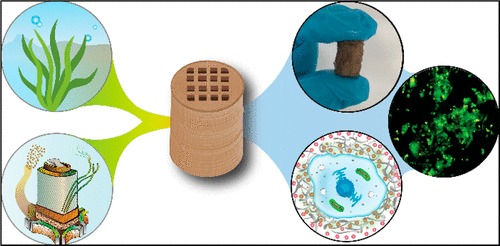当前位置:
X-MOL 学术
›
Biomacromolecules
›
论文详情
Our official English website, www.x-mol.net, welcomes your feedback! (Note: you will need to create a separate account there.)
Three-Dimensional Printed Cell Culture Model Based on Spherical Colloidal Lignin Particles and Cellulose Nanofibril-Alginate Hydrogel.
Biomacromolecules ( IF 6.2 ) Pub Date : 2020-02-11 , DOI: 10.1021/acs.biomac.9b01745 Xue Zhang 1 , Maria Morits 1 , Christopher Jonkergouw 1 , Ari Ora 2 , Juan José Valle-Delgado 1 , Muhammad Farooq 1 , Rubina Ajdary 1 , Siqi Huan 1 , Markus Linder 1 , Orlando Rojas 1 , Mika Henrikki Sipponen 1 , Monika Österberg 1
Biomacromolecules ( IF 6.2 ) Pub Date : 2020-02-11 , DOI: 10.1021/acs.biomac.9b01745 Xue Zhang 1 , Maria Morits 1 , Christopher Jonkergouw 1 , Ari Ora 2 , Juan José Valle-Delgado 1 , Muhammad Farooq 1 , Rubina Ajdary 1 , Siqi Huan 1 , Markus Linder 1 , Orlando Rojas 1 , Mika Henrikki Sipponen 1 , Monika Österberg 1
Affiliation

|
Three-dimensional (3D) printing has been an emerging technique to fabricate precise scaffolds for biomedical applications. Cellulose nanofibril (CNF) hydrogels have attracted considerable attention as a material for 3D printing because of their shear-thinning properties. Combining cellulose nanofibril hydrogels with alginate is an effective method to enable cross-linking of the printed scaffolds in the presence of Ca2+ ions. In this work, spherical colloidal lignin particles (CLPs, also known as spherical lignin nanoparticles) were used to prepare CNF-alginate-CLP nanocomposite scaffolds. High-resolution images obtained by atomic force microscopy (AFM) showed that CLPs were homogeneously mixed with the CNF hydrogel. CLPs brought antioxidant properties to the CNF-alginate-CLP scaffolds in a concentration-dependent manner and increased the viscosity of the hydrogels at a low shear rate, which correspondingly provide better shape fidelity and printing resolution to the scaffolds. Interestingly, the CLPs did not affect the viscosity at high shear rates, showing that the shear thinning behavior typical for CNF hydrogels was retained, enabling easy printing. The CNF-alginate-CLP scaffolds demonstrated shape stability after printing, cross-linking, and storage in Dulbecco's phosphate buffer solution (DPBS +) containing Ca2+ and Mg2+ ions, up to 7 days. The 3D-printed scaffolds showed relative rehydration ratio values above 80% after freeze-drying, demonstrating a high water-retaining capability. Cell viability tests using hepatocellular carcinoma cell line HepG2 showed no negative effect of CLPs on cell proliferation. Fluorescence microscopy indicated that HepG2 cells grew not only on the surfaces but also inside the porous scaffolds. Overall, our results demonstrate that nanocomposite CNF-alginate-CLP scaffolds have high potential in soft-tissue engineering and regenerative-medicine applications.
中文翻译:

基于球形胶体木质素颗粒和纤维素纳米原纤维-藻酸盐水凝胶的三维打印细胞培养模型。
三维(3D)打印已经成为制造用于生物医学应用的精密支架的新兴技术。纤维素纳米原纤维(CNF)水凝胶因其剪切稀化特性而作为3D打印材料备受关注。纤维素纳米原纤维水凝胶与藻酸盐的结合是一种有效的方法,能够在存在Ca2 +离子的情况下使印刷的支架发生交联。在这项工作中,球形胶体木质素颗粒(CLP,也称为球形木质素纳米颗粒)用于制备CNF-藻酸盐-CLP纳米复合支架。通过原子力显微镜(AFM)获得的高分辨率图像显示CLP与CNF水凝胶均匀混合。CLP以浓度依赖的方式为CNF-藻酸盐-CLP支架带来了抗氧化特性,并在低剪切速率下增加了水凝胶的粘度,从而为支架提供了更好的形状保真度和印刷分辨率。有趣的是,CLP在高剪切速率下不影响粘度,表明保留了CNF水凝胶的典型剪切稀化行为,从而易于印刷。CNF-藻酸盐-CLP支架在印刷,交联和在含Ca2 +和Mg2 +离子的Dulbecco磷酸盐缓冲溶液(DPBS +)中保存,长达7天后显示出形状稳定性。3D打印的支架在冷冻干燥后显示相对水合比值超过80%,表明具有很高的保水能力。使用肝癌细胞系HepG2进行的细胞活力测试显示CLP对细胞增殖没有负面影响。荧光显微镜检查表明,HepG2细胞不仅在表面生长,而且在多孔支架内部生长。总体而言,我们的结果表明,纳米复合CNF-藻酸盐-CLP支架在软组织工程和再生医学应用中具有很高的潜力。
更新日期:2020-01-29
中文翻译:

基于球形胶体木质素颗粒和纤维素纳米原纤维-藻酸盐水凝胶的三维打印细胞培养模型。
三维(3D)打印已经成为制造用于生物医学应用的精密支架的新兴技术。纤维素纳米原纤维(CNF)水凝胶因其剪切稀化特性而作为3D打印材料备受关注。纤维素纳米原纤维水凝胶与藻酸盐的结合是一种有效的方法,能够在存在Ca2 +离子的情况下使印刷的支架发生交联。在这项工作中,球形胶体木质素颗粒(CLP,也称为球形木质素纳米颗粒)用于制备CNF-藻酸盐-CLP纳米复合支架。通过原子力显微镜(AFM)获得的高分辨率图像显示CLP与CNF水凝胶均匀混合。CLP以浓度依赖的方式为CNF-藻酸盐-CLP支架带来了抗氧化特性,并在低剪切速率下增加了水凝胶的粘度,从而为支架提供了更好的形状保真度和印刷分辨率。有趣的是,CLP在高剪切速率下不影响粘度,表明保留了CNF水凝胶的典型剪切稀化行为,从而易于印刷。CNF-藻酸盐-CLP支架在印刷,交联和在含Ca2 +和Mg2 +离子的Dulbecco磷酸盐缓冲溶液(DPBS +)中保存,长达7天后显示出形状稳定性。3D打印的支架在冷冻干燥后显示相对水合比值超过80%,表明具有很高的保水能力。使用肝癌细胞系HepG2进行的细胞活力测试显示CLP对细胞增殖没有负面影响。荧光显微镜检查表明,HepG2细胞不仅在表面生长,而且在多孔支架内部生长。总体而言,我们的结果表明,纳米复合CNF-藻酸盐-CLP支架在软组织工程和再生医学应用中具有很高的潜力。


























 京公网安备 11010802027423号
京公网安备 11010802027423号